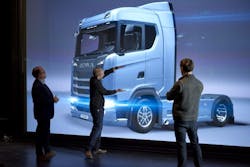Scania’s got a new truck, but not for North America. Not yet at least.
It’s always a treat to watch a new truck get introduced, with all the flash and hype that’s usually only reserved for swanky new sports cars.
That’s certainly the case for the new big rig being rolled out by Swedish truck maker Scania, which is part of Volkswagen Truck & Bus GmbH; an all-new platform that’s been 10 years in the making, with the OEM investing some $2.39 billion over that time span to bring it to life.
You can watch the introduction Scania’s new truck below at its splashy press event held in Paris, France, this week:
Indeed, Scania’s executives felt that Paris served as an “ideal location” for the launch of its new truck, as the famed “City of Light” is a home for “design innovation.”
You can watch that part of the introduction, along with other highlights, in the clip below:
Aside from all the glitz, however, and despite it being hailed as a “global truck,” North American fleets won’t see this ride anytime soon. Indeed, its cabover design doesn’t mesh with the conventional cab sensibilities on this side of the pond, though the new Scania is certainly going to fit well with fleet needs in other markets around the world.
There are, however, a few takeaways worthy of note for North American fleet operators from this new truck – especially as Scania is trying to leverage its vertically-integrated truck platform to generate more savings for its customers.
[If you want to read up on all the nitty-gritty details about this new truck, go here for all the press materials.]That’s not just in terms of better fuel economy, though the OEM touted that its new truck should achieve a 5% improvement in fuel efficiency compared to its current models (with 3% coming from powertrain improvements and 2% due to better aerodynamics).
One of the bigger advances stems from the OEM’s “Scania Maintenance” program, which I’ve noted in this space before; a program that bases truck maintenance on data, not mileage, and purportedly can extend engine oil drain intervals out to 150,000 kilometers under the right circumstances – that’s 93,000 miles for fleets on this side of the pond.
Those kinds of predictive maintenance abilities are only possible due to the rise of the “connected truck,” which is something Scania views as “unavoidable” in the European Union of 2016.
Indeed, the OEM said it now has over 200,000 connected vehicles on the road, with 95% of all its trucks delivered in Europe now “connected” vehicles.
“Our assessment is that within a few years, quality, user-friendliness and the actual benefit of the services that connectivity enables will mark the great dividing line in the industry between premium manufacturers and all the rest," noted Mattias Lundholm, head of connected services at Scania, during the OEM’s press event.
“Offering a cleverly designed range of connected services and added value increases a hauler’s competitive edge and contributes to more profit," he explained.
Certainly, Scania thinks this new truck will do that and more for European motor carriers, as well as others in selected markets around the world. We’ll see if those capabilities come to life as promised.

